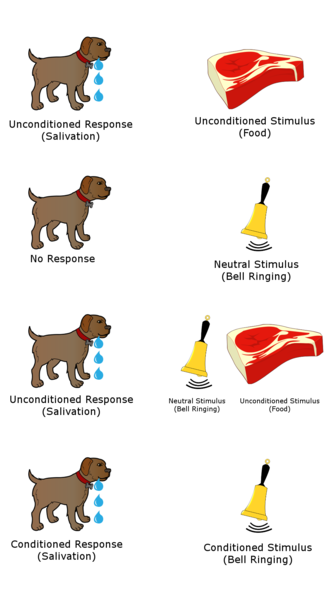Top 10 Famous Psychology Experiments
There are infinite mysteries surrounding the human beings – some were solved and some remained as mysteries. People are always finding ways to solve the mysteries – to understand one another even better and seek out for the reasons behind some actions. Psychology is one of the ways to know more about people and through psychology experiments, we find out more about people – why they act like that, what makes them do it and a lot more. Here are the top 10 famous psychology experiments that have made a great impact on our lives!
1. Pavlov’s Dogs
Have you ever heard the name Pavlov somewhere before? Well, Pavlov’s dogs became the subject of a famous psychology experiment back in 1902. It started out when a man named Ivan Pavlov noticed that his dog began salivating whenever his lab assistant was around. Since then, he began observing and making an experiment out of this. He replaced the lab assistant with the ring of a bell which signified the dog’s eating time and the dog began salivating whenever he heard the bell. Soon, he discovered that certain, automatic responses like reflex movements (ex: salivating) could be conditioned by associating a neutral stimulus (in this case, the bell) and the stimulus (food). The funny thing is the man who conducted the experiment is no psychologist. He began by studying the digestive system of a dog. Funny how things take a completely different turn, right?
2. Harlow’s Monkey
Although how controversial this experiment may seem to be, we can’t dismiss the fact that this experiment has contributed so much to the psychology. This series of experiments was first performed by psychologist Harry Harlow in the 60’s. His experiments were more often very cruel though and received many complaints but regardless, we must admit the results have given us better understanding of a child development.
Perhaps, the most notable work of Harry Harlow is the Harlow’s Monkey Psychology Experiment. Yes, as the name suggests, the experiment has something to do with monkeys. The experiment began by separating a monkey’s infant from its birth mother right after the baby was born. Then, the infant was given access to two makeshift mothers – a wire mother who provided food for the infant and a mother made of soft-terry cloth designed to give comfort. The infant turned out to preferring the comfort of a cloth mother more than the wire mother. The infant would only go to wire mother for food. When Harlow scared the infant, the infant would run to the clothe mother instead of the wire mother. This proved that in maternal bonds, security and comfort are important. So, don’t forget to give the security and comfort your child needs, alright? Remember, nourishment is not the only thing they need.

3. The Monster Study
The monster study is a name for an experiment conducted back in 1939 and like the name suggested, the experiment was unethical and horrid. The experiment was done by a speech pathologist named Dr. Wendell Johnson who wanted to know what causes stutters. He believed that stutters are not inherited. So, he brought together 22 orphaned children and split them in two groups. One group which consisted of stutterers is given positive speech therapy while the other group which mostly consisted of children who spoke normally were reprimanded and constantly put down by the experimenter. Many of the children who received negativity retained speech issues. The good news is that Johnson’s belief turned out to be true however the method to get the proof is very cruel. Even, University of Lowa apologized formally in 2001 for the horrifying experiment.
4. Marshmallow
Children ranging from ages 4 to 6 were taken into a room with a marshmallow placed on top of the table and they were left alone for 15 minutes. Maybe you are wondering why. After all, what is the point of doing it? Well, this is an experiment conducted by Walter Mischel from Standford University in 1972. He was questioning whether deferred gratification is one of the qualities to achieve success in the future. The children were not only left alone in the room. They were told that if the marshmallow were still on the table after 15 minutes, they will get second marshmallow. Some ate the marshmallow and some resisted the temptation long enough to get the second marshmallow. Mischel found that children who waited 15 minutes to get the second marshmallow were more likely to receive higher SAT scores and more competent than those who didn’t wait. Perhaps, that’s the reason why there’s a saying that goes, “Patience is the key.”
5. Blue eyed vs Brown eyed
The person behind this experiment is not a psychologist. Her name is Jane Eliott and she was a teacher in an elementary school. Still, she managed to develop one of the most famous, controversial exercises in the psychology world. The teacher was inspired when there was news about the assassination of Martin Luther King Jr and decided to teach her students about racism to understand it better by diving the class in two sections – the blue eyed and brown eyed groups. The blue-eyed was the superior one while brown one became the inferior one. Throughout the day, brown-eyed group was treated as being far more degrading than the blue-eyed ones. The next day, they switched so all of the students endured the same process, becoming both superior and inferior. At the end of the exercise, they all agreed that discrimination is a bad thing and they hugged one another. After all, raising awareness should be done early in childhood, right?

6. The Asch Conformity Experiment
Admit it, there must be times in your life where you succumb to peer pressure. It’s perfectly normal to do so and a study has shown that people tend to adapt to the situations in a group of people. A series of experiments conducted in 1951 are the evidence supporting the theory. A subject was placed in a room full of actors and they were shown a picture with 3 numbered lines and each was asked a question which is the longest line. The actors were assigned to answer falsely to determine whether the subject would simply follow the actors or give the right answer. Apparently, the subject went along with the actors. It is in human nature to adapt to the situations, after all.
7. Little Albert
This experiment conducted by John B. Watson and his partner, Rosalie Rayner in 1920 at Johns Hopkins University, was similar to Pavlov’s Dogs experiment except the experiment was done on humans and was known to be one of the most unethical psychology experiments – well, how could it not? The experiment was mistreating an infant by provoking fear within him. A 9-month-old Albert was exposed to white rats and other furry animals and Albert was fond of playing with them. That was until Watson started hitting a hammer against the steel bar behind Albert. Albert would then proceed to burst into tears. It was done 7 times in 7 weeks when Albert was 11-months-old and since then, Albert would start bawling whenever he saw white rats and other similar furry animals, even without the sound of hammer hitting against the steel bar. Little Albert associated the white rats with the loud noise and hence the reason why he was scared. This is what we call irrational fear or phobia. Unfortunately, Albert died at the age of 6 after developing hydrocephalus so whether phobia lasted up until adulthood or not is unknown. From this experiment, Watson believed that classical conditioning explained all aspects of human psychology – that differences in each individual were caused by the differences in learning experience.
The most controversial psychology experiment so far?
8. The Bystander Effect
Being in a place full of people does not mean your safety is guaranteed. Being in a crowded place when you need help does not mean people will come offering help. Yes, you haven’t read the previous sentence wrong, you’ve read it correctly. You must be wondering why though. More people means higher chance of getting help when you need it, right? Apparently an experiment conducted by John Darley and Bibb Latané had proven otherwise. The experiment began when the pair had developed an interest in The Murder of Kitty Genovese Case – a murder which was not prevented even though there were many witnesses. 37 or 38 witnesses ignored it even though they saw and heard Kitty Genovese being assaulted which led to another question, why?
The pair performed the experiment by leaving a participant to fill a survey in a room and then, harmless smokes will start seeping into the room. The result of this experiment was solo participant was more likely to report the smokes faster than those who were in a group. This phenomenon was named The Bystander Effect or Genovese Syndrome. This effect stated that people are less likely to offer help when there are a lot of people because they have the assumption that someone else will help. Social status also plays a role in the effect.

9. Zimbardo’s Prison Experiment
When speaking of the most famous and yes, controversial psychology experiments, we must include the Zimbardo’s Prison Experiment. The guards in American prisons were known to be brutal and the situation caught the attention of Zimbardo who conducted the experiment by assembling a roleplay which simulated prison life and assigning participants of the experiment to be the guards and prisoners randomly. The experiment’s purpose was to find out whether the participants will conform to their roles easily and display an aggressive behavior or remain the same as they were before roleplaying. Zimbardo kept the exercise as real life as possible and converted the basement of Standford University into a mock prison. The prisoners were also arrested at home without notice and brought to the local police station – much like any other criminals. They were identified by their ID numbers as well – it was done in purpose of making the prisoners feel anonymous with themselves. It didn’t take long for both the prisoners and the guards to adapt to their roles – the guards started showing violent behavior while the prisoners were submissive to their aggressive behavior. It was brutal – the prisoners started showing signs of emotional disorders that seemed to have lasting effect and the guards were as aggressive as ever. The experiment was put to an end by Christina Maslach on the sixth day, a recent Standford Ph.D who was assigned to conduct an interview with the prisoners and guards. She was quoted saying, ‘It's terrible what you are doing to these boys!” Initially, the experiment was supposed to run for a fortnight. Needless to say, Zimbardo reached the conclusion that people will adapt to the social roles they are expected to play.
10. The Milgram Experiment
The last psychology experiment that’s to be covered on the list is none other than The Milgram Experiment. The experiment started because people who were accused of genocide acts at World War II justified their actions by saying that they were only following orders from their superiors. Milgram, a psychologist at Yale University, questioned how far people will go to follow order even if it meant harming people. Then, he conducted an experiment in July 1961. The experiment was concentrating on the conflict between obedience to authority and personal conscience. He put an advertisement for male on the newspaper to take part in the experiment. There are two roles assigned for the participants – one would become the learner and the other would be the teacher. However, the draw was fixed so the participants were always the teacher and the actors were the learner. The actor was taken into a separate room with electrodes attached to his arms and the participant was taken into the next room with another researcher. The next room was equipped with an electric shock generator and a row of switches marked from 15 volts (Slight Shock) to 375 volts (Danger: Severe Shock) to 450 volts (XXX). Every time the learner makes a mistake, the teacher is told to administer the electric shock and with each mistakes the learner makes, the level of shock will be increased. The learner purposely made mistakes so the teacher is given no choice but to administer electric shock and when the teacher refused, there will be the researcher who gave prods to ensure it continues. The result is 65% of the participants continued up until the highest level of electric shock (450 volts) even though they were told that it can danger the learner and none of the participant stopped below 300 volts. The experiment however was biased because it’s only tested on male and it can’t be seen as the representative of American citizens.








